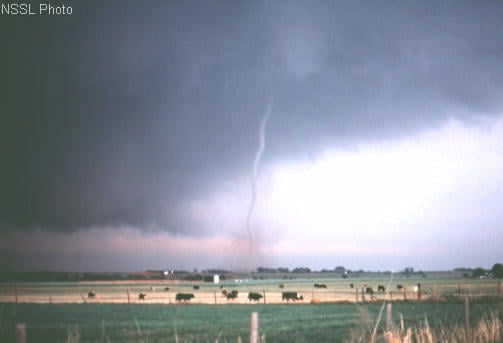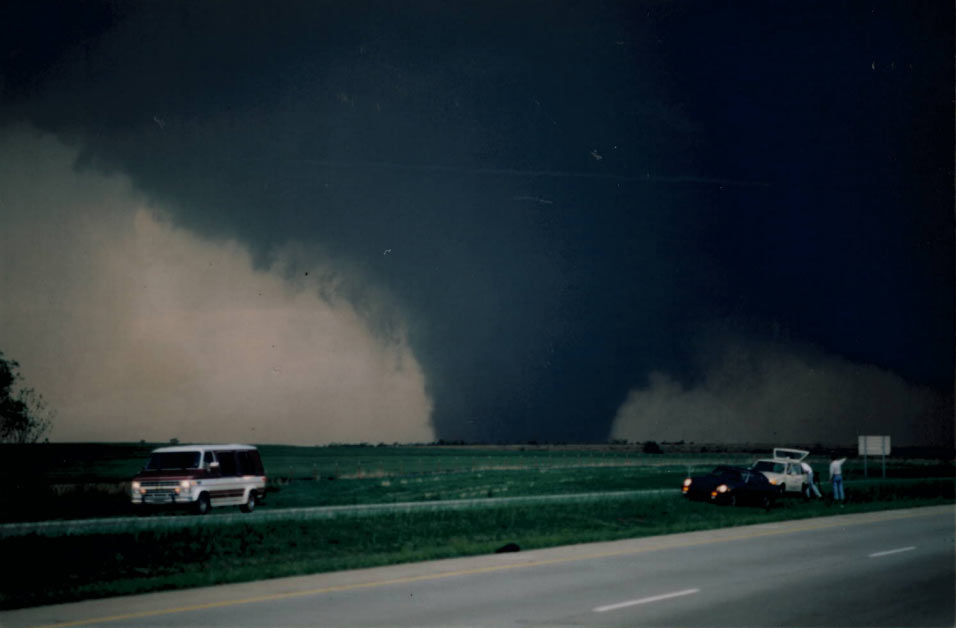
Tornadoes have been hitting U.S. headlines recently as unusually severe weather is experienced in the Midwest and above-average tornado activity was noted earlier in the year. Alabama, Georgia, Florida, and South Carolina, for example, saw 41 tornadoes during an outbreak of severe weather in March and the second half of May saw 483 tornadoes across the U.S. According to NOAA, an average of 1,253 tornadoes occur in the U.S. each year. A total of 991 were reported in 2018 and NOAA has recorded 935 so far this year—and the peak season isn’t quite over yet.
One of the news stories I read recently talked about a wedge tornado and today I read another that referred to a landspout tornado. I figured it was a good time to blog about tornado types.
About 20% of supercell thunderstorms produce tornadoes—rapidly rotating columns of air, connected to the base of a thunderstorm and in contact with the ground. Weaker tornadoes generally last about 10 minutes and travel only short distances, while stronger tornadoes may last for several hours and can travel hundreds of miles. Tornadoes come in many shapes and sizes and may transition from one form to another several times if they are on the ground for longer periods. Many apt names, such as elephant trunk and drill bit, have been used to describe the shapes tornadoes can assume, but there are a few essential forms:
Rope Tornado
The slenderest and most common form of twister is the rope tornado. While many twisters develop into larger forms, most start and end as rope tornadoes, although some brief twisters retain their rope-like appearance for their whole life cycle.

Cone Tornado
These are what everyone pictures when they hear the word “tornado.” They are wider at the base than rope tornadoes, and much wider where they meet the thunderstorm, giving them a conical appearance. Because their footprint and path are wider, they can leave a larger trail of destruction. A similar form where the twister’s width at ground level and at the base of the thunderstorm are similar is called a cylinder or stovepipe tornado.
Wedge Tornado
Wider still and broader than they are tall, wedge tornadoes are some of the largest tornadoes and can be among the most destructive. They are usually rated at EF-3 or above and with a width of half a mile or more, can leave a significant trail of destruction. The May 2013 El Reno tornado in Oklahoma was 2.6 miles wide at the height of the storm.

Multi-Vortex and Satellite Tornadoes
A few supercell thunderstorms spawn multiple tornadoes at the same time. Multi-vortex describes a tornado that has two or more smaller subvortices swirling around the center. Each subvortex can produce localized areas of much higher winds than the parent circulation. This can cause patterns of extreme damage next to very little damage. Subvortices are usually not visibly distinguishable due to dirt and debris being carried upward. In extremely rare cases a satellite tornado may form near a larger existing tornado from the same storm. These are located farther from the primary tornado and are visibly distinguishable. They will orbit the main tornado and eventually dissipate or merge.
Non-Supercell Tornadoes
These are circulations that do not originate with organized storm rotation, but rather develop from a vertically spinning parcel of air occurring near the ground. Cool air descending from the Rockies into the dry air of the plains, for example, can trigger small non-supercell tornadoes in eastern Colorado. Landspouts and waterspouts—narrow condensation funnels that form from a spinning motion originating near the surface before developing thunderclouds overhead have created a rotating updraft—are also non-supercell tornadoes. Gustnadoes are another example. Non-supercell tornadoes are usually weaker than those forming from supercell thunderstorms.
Size Isn’t Everything
Most twisters have forward wind speeds ranging from stationary to about 70 mph and rotate cyclonically with wind speeds ranging from 40 to 110 mph (although they can be more than 300 mph). They are one of the most destructive forces in nature.
A tornado’s strength and destructive power, however, are not dependent on its shape or width. Twisters tend to vary in intensity regardless of shape, size, and location, although stronger tornadoes tend to be larger than weak ones. Longer track tornadoes also tend to be stronger than those that have a short track, however these correlations are quite weak given the considerable complexity of severe weather systems.
For a synopsis of U.S. twisters, see our infographic “The Anatomy of a Tornado”



